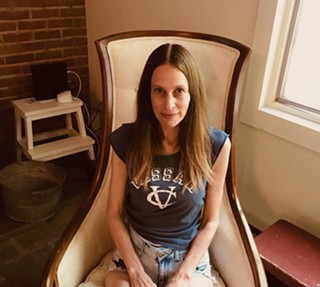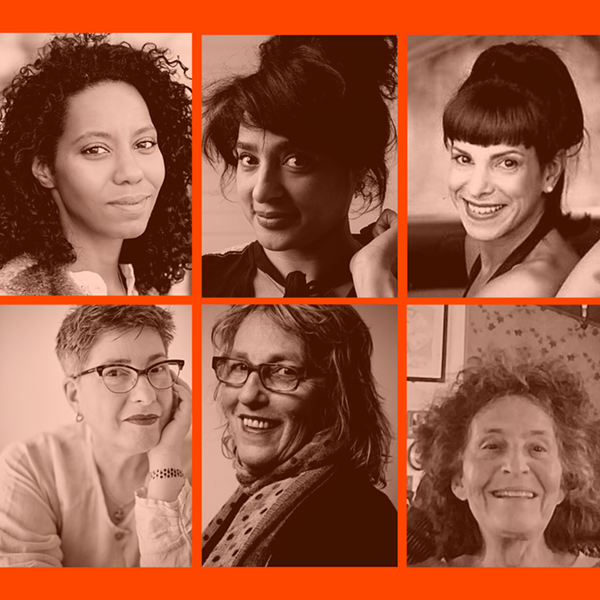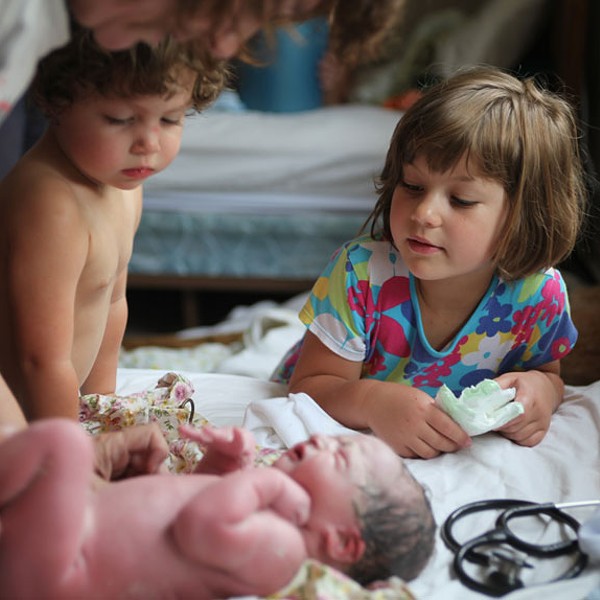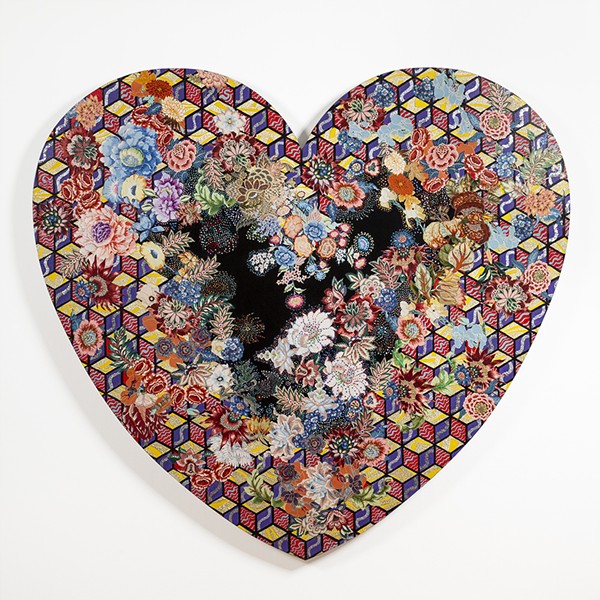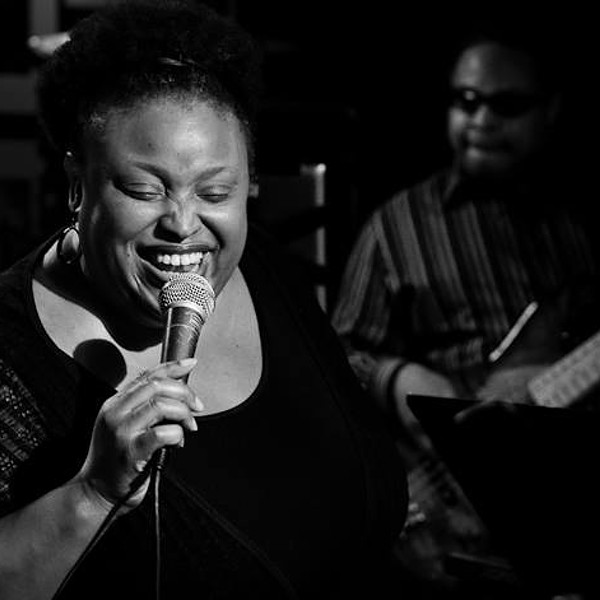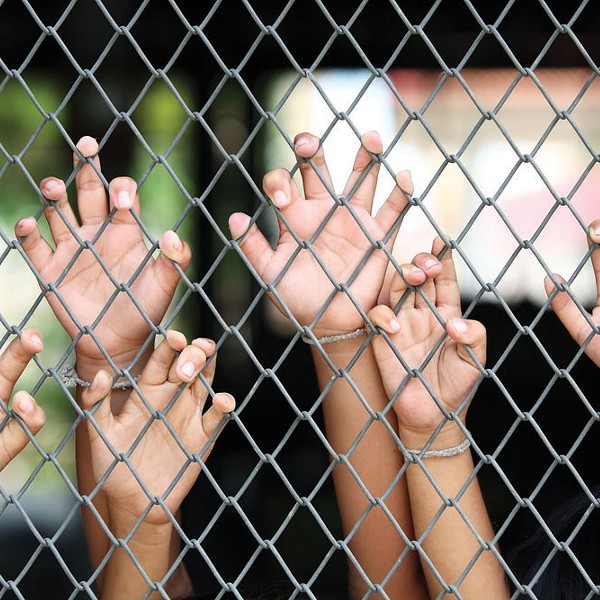The cats knew something was up. At first, when a Buddha-bellied Woodley Humphreys was in the thick of labor, her two felines, Sidney and Asrael, hid upstairs. “They were scared in the beginning,” recalls Humphreys. “But eventually they came down to watch.” Unlike most expectant women, Humphreys never left home when her quickening contractions signaled true labor and imminent birth. Instead her husband, Jason Lipka, gathered towels and began setting up a sterilized birthing tub on the kitchen floor of their Rhinebeck apartment. And unlike most women in her state, Humphreys never traded her pajamas for a hospital gown. Instead her birth team—midwife Connie Kieltyka, doula Mary Riley, and labor-and-delivery nurse Kim Bissell—showed up at her doorstep on that late April night. “As soon as they walked in, they focused on me,” says Humphreys. “Mary was keeping me centered with her coaching, and Connie was attentive enough to make me feel safe, but she wasn’t intrusive.” Labor was “the hardest work ever,” but with that kind of support, says Humphreys, “it never felt unbearable.” Finding comfort in the bath, Humphreys writhed her way toward a water birth. At 1:38 a.m., after four hours of hard labor and a half-hour blitz of pushing, 7-pound, 14-ounce Holden Lipka was born in the rigged-up tub in the kitchen, caught in midswim by his father—under the watchful eyes of two curious pussycats.
These days, women have more opportunities to birth their babies at home, literally surrounded by their creature comforts. Popular in the free-love ’70s, home birth retreated in the more conservative ’90s and early ’00s, but it’s back again. Though still uncommon—accounting for less than 1 percent of births nationwide—the home birth rate has been quietly spiking. Between 2004 and 2009, according to the Centers for Disease Control, the number of home births in this country rose 29 percent, to 29,650. In the midst of this period, a 2007 Ricki Lake documentary, The Business of Being Born—a scathing critique of the standard hospital birth model pitted against cozy images of women birthing where they choose—gave the home-birth movement a palpable jolt in popularity. And after the supermodels Karolina Kurkova and Gisele Bündchen both delivered at home, a June 2012 article in the New York Times Style section coyly asked if home birth might be entering the realm of the chic: “Are midwives becoming trendy, like juice cleanses and Tom’s shoes?” Not all the press for home birth is so insouciantly upbeat, however: Many articles and blogs hone in on the fears and risks surrounding this maverick approach to bringing a child into the world. Yet a strong set of voices is threading through the debate, claiming home birth as a safe, valid option for expectant mothers and their partners.
A Choice for Healthy Women
Today’s home birth midwives might have to deal with controversy or skepticism from a less than welcoming, highly medicalized birth culture. But they counter distrust with one caveat: their unassailable expertise. The home birth midwives of the Hudson Valley are an overeducated bunch; schooled in both Western medicine and traditional practices, they have strikingly impressive backgrounds and resumes. Take Humphreys’ midwife, Connie Kieltyka. Though she started her Olivebridge-based home birth practice only a year ago, she spent the last 23 years preparing—first as a doula, then as a labor-and-delivery nurse before working with an OB on high-risk pregnancies and training with a traditional midwife in Mexico. “I think I have a nice balance of hospital midwifery and traditional midwifery, and I can use both in my practice,” says Kieltyka, who like all midwives also provides gynecology care and consults with other medical experts as needed. “I’m medically aware and I keep safe, but at the same time I trust nature—for healthy women. I’d refer a high-risk woman to a hospital practice. It’s best to leave the complicated cases to the OBs. Most problems present themselves long before labor starts. A midwife is trained in normal birth.”
Humphreys fit the bill for a textbook low-risk pregnancy; when she arrived at Kieltyka’s office, she was already deep into her third trimester and feeling great. Home birth was something that she had begun to explore only after first trying the conventional route: a hospital-affiliated practice of OBs and midwives. “I had a good experience there,” she says, “but it was a rushed experience.” Her time-pressed visits with overworked caregivers often left her anxious—and pining for the naturopathic and alternative medical approaches that she gravitated toward. So with her pregnancy ripening at 35 weeks, she changed course. “When I met Connie, I instantly felt at ease,” she recalls. “The difference was night and day. Connie spent so much time with us—an hour and a half at one appointment. She thoroughly reviewed my medical history and suggested some homeopathic remedies to help prepare for birth. She was always available; I could call her anytime. Her biller set us up with insurance coverage. It was easy.”
Laboring at home—while not exactly the easy part—is an entirely different experience from laboring in a hospital or birth center. “At home, you can be comfortable,” says Kieltyka. “There’s not so much pressure to act a certain way. You don’t have strangers coming into the room, changes of shift; the same person that you’ve known throughout the prenatal period is there at the birth. The woman has a lot more freedom to walk around, eat and drink, wear clothes or not. I think being at home helps her to open up more. You don’t have to be on a certain time schedule or else you’re going to be induced—or else this, or else that. I don’t think you experience pain in the same way, so your body is able to open up more easily.”
Less Fear, More Trust
At first glance, earthy, grounded women like Humphreys and Kieltyka don’t seem like rabble-rousers. But choosing to birth at home is in some ways a subversive act: It’s going against the grain of our culture and conventions. “We’re off the grid, a little bit fringe, a little bit unaccepted by society,” says Jenna Houston, a home birth midwife with offices in Catskill and Hudson. In her 35-plus years in the field, says Houston, “I’ve seen everything from high-tech births and the overuse of technology, with its bad outcomes, to squatting on a dirt floor—which is in many ways safer and certainly more human. In certain countries it’s the inaccessibility of technology that’s the problem. But in this country it’s the depersonalization, not really knowing the woman and not spending the time doing preventative work, the educational part. The notion with home birth is that you respect your clients and are sharing information and decision-making—not just handing yourself over to the system, which so misuses its resources and technology. The medical model is so fear-based that it’s hard to see beyond that. It’s disempowering.”
Anyone familiar with today’s maternity world will have a taste of the fears that haunt expectant mothers at every turn: the battery of prenatal tests, the false positives, the branding of “advanced maternal age” for pregnant women over 35. Ironically, so much about modern maternity is paternalistic and intimidating—but it doesn’t have to be this way. “This is a women’s rights issue,” says Bearsville-based doula Mary Riley. “We need information, and not fear-based information, to make the right choices. When something goes wrong with a home birth you’re going to read about it in the paper. Not so with a hospital birth. There’s a feeling that when we’re in a hospital we’re safe, but standard hospital interventions can actually cause problems.” Neither Riley nor Houston are alone in thinking that the C-section rate in this country is way too high—over 32 percent. And both women, veterans of the birth world, are seeing more induction and more monitoring in hospital settings. “Today, we have birth centers and it seems all nice and homey, but it’s not—it’s a façade of natural,” says Houston. “The system is so entrenched. Hospital practices are bigger, so mothers have to meet five or six practitioners—you don’t know who you’re going to get. It’s a whole different relationship when you’re working with a home birth midwife.”
An Extra Special Delivery
Listening to impassioned voices like these, home birth seems like a no-brainer of a choice. But not so fast: Even a fervent birth activist will say that it’s not the right option for everyone. Expectant parents choosing home birth must be willing to take responsibility and to assume an active role in their own health care. Home birth couples should be willing to ask questions—such as to inquire about a back-up plan in case a hospital transfer is necessary, and to ask a midwife about her transfer rate (for Houston, it’s three percent). Another logistic to work out is finances—though in most cases insurance companies will cover home birth. (Says Kieltyka, who has been known to accept the occasional barter payment from a client, “I will very rarely turn someone away because of money.”) Most important, mothers must feel comfortable with the idea of birthing naturally at home—because only if you feel safe in your surroundings and circle of support will your body open up and let birth happen.
“Before our experience I’d heard about home birthers, and I can’t say I felt like one,” says Humphreys’s husband, Jason Lipka, a financial planner. “Connie answered all of my ‘what if’ questions.” Now he and Humphreys couldn’t imagine doing it any other way. By the end, says Lipka, the birth team felt like part of the family; there was intimacy and trust. “After the birth Connie did all the required things and then some,” says Humphreys. “She and Mary got us situated and snuggled in; they made me peanut butter toast and cleaned our kitchen. Kim diapered and swaddled Holden and got me started with breastfeeding. They left around dawn, but Connie was back a few hours later to check in. I hadn’t left my bed; I was comfortable in my own room. There’s nothing better than that.” During the postnatal period, Humphreys stayed cuddled in with her baby longer than most mothers do. Instead of juggling with infant car seats and gear on the way to OB/GYN appointments, she enjoyed house calls from her caregiver.
For Riley, who has served as a doula at some 1,700 births, a home birth is all about women’s empowerment and autonomy—from freedom of choice to the flexibility and power of the birth experience itself. “At home, women are free to labor outside, walk in the woods, breathe some air,” she says. “There’s more freedom in their movement during labor and birth. I’ve seen babies delivered outside, under trees, in a barn, all sorts of places. Women are wild.”
Resources
Connie Kieltyka, CNM, LM Olivebridgemidwifery.com
Jenna Houston, CNM, LM Midwifejennahouston.com
Mary Riley, CCE, CD (845) 679-6565
- Home
- Arts
- Food & Drink
- Towns
- Home & Design
-
Towns
- Accord
- Amenia
- Beacon
- The Berkshires
- Catskill
- Chatham
- Cold Spring
- Cornwall
- Ellenville
- Gardiner
- Garrison
- Germantown
- Goshen
- Great Barrington
- Hunter
- High Falls
- Highland
- Hillsdale
- Hopewell Junction
- Hudson
- Hyde Park
- Kerhonkson
- Kinderhook
- Kingston
- Marlboro
- Middletown
- Millbrook
- Millerton
- Montgomery
- Mount Tremper
- New Paltz
- New Windsor
- Newburgh
- Orange County
- Pawling
- Peekskill
- Phoenicia
- Poughkeepsie
- Putnam County
- Red Hook
- Rhinebeck
- Rosendale
- Saugerties
- Stone Ridge
- Sugar Loaf
- Tivoli
- Wappingers Falls
- Warwick
- Woodstock
- Westchester
- Lifestyle
- Horoscopes
- Cannabis
- Wellness
- The River
- Events
- Chronogrammies
- Newsletters
- Add Your Event
- Support Us
- Login
- sign in
- Username
Home Birth Revolution
Giving Women the Opportunity to Choose Where They Deliver is a Labor of Love for Today's Home Birth Midwives and Doulas.
By Wendy Kagan
[]
Tags
About The Author
Wendy Kagan
Wendy Kagan lives and writes in a converted barn at the foot of Overlook Mountain in the Catskills. She served as Chronogram's health and wellness editor from 2011 to 2022.
Support Chronogram
Related Content
Website
Chronogram








